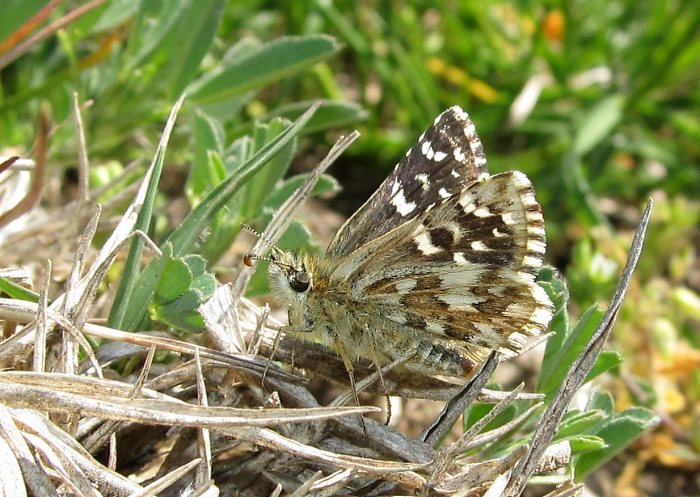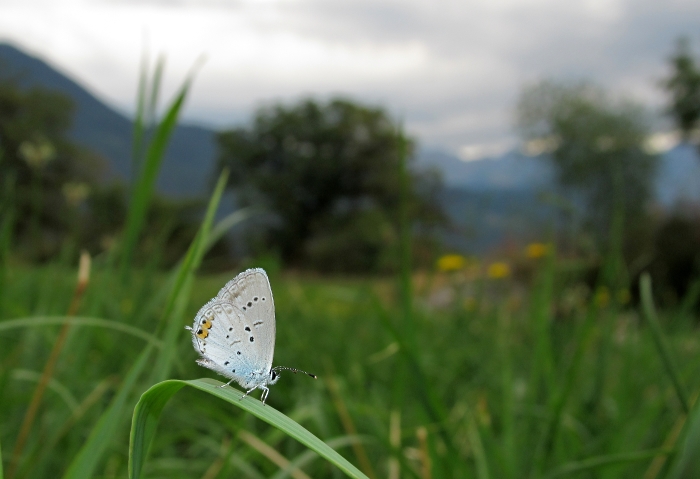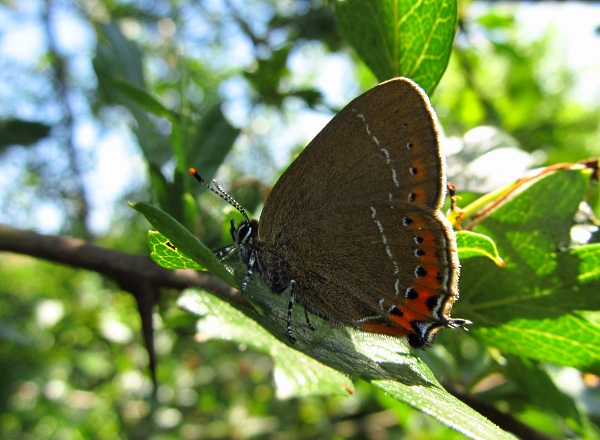Does anyone regularly use fill-flash for butterfly photography? I would like to try it in dull conditions, hopefully thereby keeping the ISO low. Any tips or info?
Tony M.
Fill flash
- Padfield
- Administrator

- Posts: 8373
- Joined: Sun Nov 05, 2006 10:19 pm
- Location: Leysin, Switzerland
- Contact:
Re: Fill flash
As I think you know, I'm not really a photographer, in the sense you are, and I hesitate to reply to a photography post. But yes - I do use flash under certain circumstances. It is particularly useful for undersides of butterflies on hot days, when they are either angled end-on to the sun or with wings half-open, so the underside is in shade.
This baton blue would have looked dark grey against the background without flash:

Similarly, the undersides of these rosy grizzled skippers - so important for identification - would have been in shade in both these pictures without flash:


It works best when the backdrop is bright, so the butterfly doesn't seem artificially illuminated. This short-tailed blue doesn't really work:

Flash definitely changes the colour balance and texture of butterflies (it flattens them) but does, as you say, allow sharp pictures in poor conditions. This black hairstreak was taken in the shade on a bright day (or, looking at the picture, its shady side was towards me - I remember I had to use flash):

Guy
EDIT - I've found a non-flash photo of the same black hairstreak:

This baton blue would have looked dark grey against the background without flash:

Similarly, the undersides of these rosy grizzled skippers - so important for identification - would have been in shade in both these pictures without flash:


It works best when the backdrop is bright, so the butterfly doesn't seem artificially illuminated. This short-tailed blue doesn't really work:

Flash definitely changes the colour balance and texture of butterflies (it flattens them) but does, as you say, allow sharp pictures in poor conditions. This black hairstreak was taken in the shade on a bright day (or, looking at the picture, its shady side was towards me - I remember I had to use flash):

Guy
EDIT - I've found a non-flash photo of the same black hairstreak:

Guy's Butterflies: https://www.guypadfield.com
The Butterflies of Villars-Gryon : https://www.guypadfield.com/villarsgryonbook.html
The Butterflies of Villars-Gryon : https://www.guypadfield.com/villarsgryonbook.html
Re: Fill flash
I agree with Guy that fill-in flash is best used for against-the-light shots in bright sunshine. Guy's shots demonstrate the benefits very well.
When using 'fill-in' flash mode, the camera attempts to match the flash brightness to the ambient light intensity, so it may not work as you expect in dull conditions. If your camera allows separate adjustment of flash intensity and exposure, then it is worth trying different settings to get sufficient 'lift' to the subject without making the background go completely black - the dreaded 'soot and whitewash' effect.
If you have a separate flashgun, it is best to hold it above the subject, like an artificial sun. By this technique, it is possible to get natural-looking lighting of the subject and its immediate surroundings. To do this, you either need a sync lead, to attach the flash to the camera, or a wireless flash system, or a remote flash trigger that responds to the camera's own flash (which must be shielded from the subject). I have written about my use of off-camera flash at http://home.btconnect.com/mike.flemming/flash.htm
Mike
When using 'fill-in' flash mode, the camera attempts to match the flash brightness to the ambient light intensity, so it may not work as you expect in dull conditions. If your camera allows separate adjustment of flash intensity and exposure, then it is worth trying different settings to get sufficient 'lift' to the subject without making the background go completely black - the dreaded 'soot and whitewash' effect.
If you have a separate flashgun, it is best to hold it above the subject, like an artificial sun. By this technique, it is possible to get natural-looking lighting of the subject and its immediate surroundings. To do this, you either need a sync lead, to attach the flash to the camera, or a wireless flash system, or a remote flash trigger that responds to the camera's own flash (which must be shielded from the subject). I have written about my use of off-camera flash at http://home.btconnect.com/mike.flemming/flash.htm
Mike
-
ingleslenobel
- Posts: 12
- Joined: Fri Aug 07, 2015 1:48 pm
Re: Fill flash
Using flash on a dull day for lower ISO would tend to suggest that you're using flash as key, not as fill. It's perfectly doable - but I'd suggest go out and practice on something easy first, it's helped me a lot finding my settings. The difficulty you have is black backgrounds. In my experimentation I tend to set the flash at about -1.5 EV but it's a bit of a balancing act and I have a camera set up with bracketing to give me a choice of apertures.
I've been doing research on this too, and since I'm hoping to use flash on a bright day, to have a bright, wide open buttery blurry aperture, and nice bright subject in the foreground, I've added HSS to my armoury. HSS lets you use flash at speeds faster than your flash sync speeds, which you might need if it's bright and sunny out. For example if the camera tells you to use 1/500 then you won't be able to use a flash for fill unless you use HSS.
In fact I have a setup that has both possibilities on one camera. So I've made a dual arm bracket, the flash on the right is triggered by radio and does aperture bracketing, but a different flash on the left is triggered by cord, and does HSS bracketing. There's a switch on my cord - the Nissin SC-01 - so I can toggle between flashes if I have the radio transmitter on top of the Nissin SC-01. It works well, but very heavy. Anyhow now you know who the nutter is carrying the dalek like camera setup next time you're around Dorking.
I've been doing research on this too, and since I'm hoping to use flash on a bright day, to have a bright, wide open buttery blurry aperture, and nice bright subject in the foreground, I've added HSS to my armoury. HSS lets you use flash at speeds faster than your flash sync speeds, which you might need if it's bright and sunny out. For example if the camera tells you to use 1/500 then you won't be able to use a flash for fill unless you use HSS.
In fact I have a setup that has both possibilities on one camera. So I've made a dual arm bracket, the flash on the right is triggered by radio and does aperture bracketing, but a different flash on the left is triggered by cord, and does HSS bracketing. There's a switch on my cord - the Nissin SC-01 - so I can toggle between flashes if I have the radio transmitter on top of the Nissin SC-01. It works well, but very heavy. Anyhow now you know who the nutter is carrying the dalek like camera setup next time you're around Dorking.
- Tony Moore
- Posts: 810
- Joined: Tue Jul 01, 2008 6:37 pm
Re: Fill flash
Thanks, Guy and guys for the input. Looks like a bit of practise in the garden on hoverflies... It would be tough to miss a good butterfly shot, messing about with kit 
Re: Fill flash
A good plan - with digital, there's no cost in practising your technique before being faced with that 'critical shot'Tony Moore wrote:Thanks, Guy and guys for the input. Looks like a bit of practise in the garden on hoverflies... It would be tough to miss a good butterfly shot, messing about with kit
Mike
